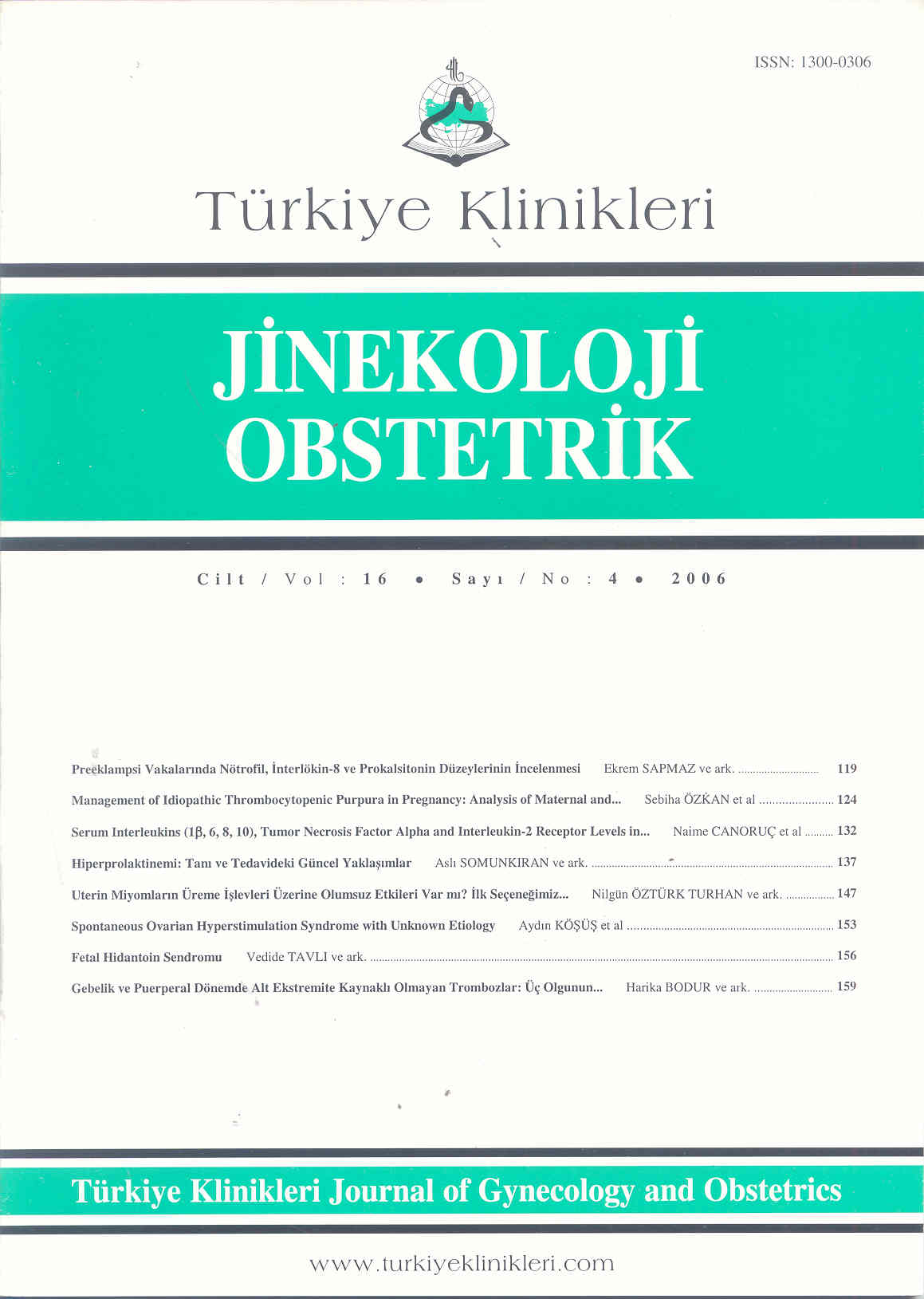Open Access
Peer Reviewed
CASE REPORTS
2100 Viewed1068 Downloaded
Spontaneous Ovarian Hyperstimulation Syndrome with Unknown Etiology: Case Report
Etiyolojisi Açıklanamayan Spontan Ovarian Hiperstimulasyon Sendromu
Turkiye Klinikleri J Gynecol Obst. 2006;16(4):153-5
Article Language: EN
Copyright Ⓒ 2025 by Türkiye Klinikleri. This is an open access article under the CC BY-NC-ND license (http://creativecommons.org/licenses/by-nc-nd/4.0/)
ABSTRACT
Ovarian Hyperstimulation Syndrome (OHSS) associated with a spontaneously conceived singleton pregnancy is rare. Many etiologic factors are detected in spontaneous OHSS. None of them was seen in this case. In this case ultrasonography of a 23 year-old woman revealed 5 weeks gestational sac with normal appearing ovaries. 2 weeks later ultrasonography revealed a viable fetus of 7 weeks gestation and enlarged, polycystic ovaries with free fluid in the pelvis. Laboratory studies, thyroid function tests, colour doppler analysis were normal. At 17 weeks gestation, ultrasonography revealed normal ovaries. The pregnancy proceeded normally. The ultrasound of ovaries, ovarian and thyroid function were normal 2 months after delivery. OHSS is related to ovulation induction but rarely it may be related to PCOS, high endogenous gonadotropin levels, hyperandrogenism, multiple gestation, molar pregnancy, hypothyroidism, mutations in the FSH receptor gene and sometimes without any identifiable cause. Spontaneous OHSS can be managed conservatively without complication.
Ovarian Hyperstimulation Syndrome (OHSS) associated with a spontaneously conceived singleton pregnancy is rare. Many etiologic factors are detected in spontaneous OHSS. None of them was seen in this case. In this case ultrasonography of a 23 year-old woman revealed 5 weeks gestational sac with normal appearing ovaries. 2 weeks later ultrasonography revealed a viable fetus of 7 weeks gestation and enlarged, polycystic ovaries with free fluid in the pelvis. Laboratory studies, thyroid function tests, colour doppler analysis were normal. At 17 weeks gestation, ultrasonography revealed normal ovaries. The pregnancy proceeded normally. The ultrasound of ovaries, ovarian and thyroid function were normal 2 months after delivery. OHSS is related to ovulation induction but rarely it may be related to PCOS, high endogenous gonadotropin levels, hyperandrogenism, multiple gestation, molar pregnancy, hypothyroidism, mutations in the FSH receptor gene and sometimes without any identifiable cause. Spontaneous OHSS can be managed conservatively without complication.
ÖZET
Spontan gebeliklerde Ovarian Hiperstimulasyon Sendromu (OHSS) nadiren gelişir. Spontan OHSS'ye neden olan pek çok etiyolojik faktör vardır. Bu vakada bunların hiçbirine rastlanmamıştır. Bu vakada, 23 yaşındaki bir kadında yapılan ultrasonografide (USG) 5 haftalık gestasyonel kese ile normal görünümlü overler tespit edildi. İki hafta sonra tekrarlanan USG'de 7 haftalık FKH (+) fetus ile bilateral polikistik, büyümüş overler ve pelviste serbest sıvı görüldü. Laboratuvar testleri, tiroid fonksiyon testleri, renkli doppler USG normaldi. 17. haftada tekrarlanan USG'de overler normal görünümdeydi. Gebelik normal seyrinde devam etti. Doğumdan 2 ay sonra yapılan USG, over ve tiroid fonksiyonları normaldi. OHSS, ovulasyon indüksiyonu sonrası gelişir. Nadiren polikistik over sendromu, yüksek endojen gonadotropin seviyesi, hiperandrojenizm, çoğul gebelik, molar gebelik, hipotiroidizm, FSH reseptör genindeki mutasyonlar buna neden olabilir. Bazen hiçbir neden tespit edilemeyebilir. Spontan OHSS, komplikasyon gelişmeden konservatif olarak tedavi edilebilir.
Spontan gebeliklerde Ovarian Hiperstimulasyon Sendromu (OHSS) nadiren gelişir. Spontan OHSS'ye neden olan pek çok etiyolojik faktör vardır. Bu vakada bunların hiçbirine rastlanmamıştır. Bu vakada, 23 yaşındaki bir kadında yapılan ultrasonografide (USG) 5 haftalık gestasyonel kese ile normal görünümlü overler tespit edildi. İki hafta sonra tekrarlanan USG'de 7 haftalık FKH (+) fetus ile bilateral polikistik, büyümüş overler ve pelviste serbest sıvı görüldü. Laboratuvar testleri, tiroid fonksiyon testleri, renkli doppler USG normaldi. 17. haftada tekrarlanan USG'de overler normal görünümdeydi. Gebelik normal seyrinde devam etti. Doğumdan 2 ay sonra yapılan USG, over ve tiroid fonksiyonları normaldi. OHSS, ovulasyon indüksiyonu sonrası gelişir. Nadiren polikistik over sendromu, yüksek endojen gonadotropin seviyesi, hiperandrojenizm, çoğul gebelik, molar gebelik, hipotiroidizm, FSH reseptör genindeki mutasyonlar buna neden olabilir. Bazen hiçbir neden tespit edilemeyebilir. Spontan OHSS, komplikasyon gelişmeden konservatif olarak tedavi edilebilir.
MENU
POPULAR ARTICLES
MOST DOWNLOADED ARTICLES





This journal is licensed under a Creative Commons Attribution-NonCommercial-NoDerivatives 4.0 International License.










